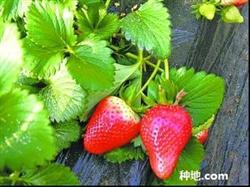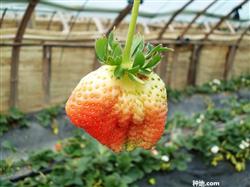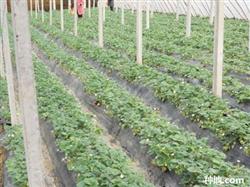What is strawberry deficiency in greenhouse?

What is strawberry deficiency in greenhouse? Strawberry deficiency has the following symptoms: first, nitrogen deficiency 1, symptoms. In general, at the beginning of nitrogen deficiency, especially in the peak growth period, the leaves gradually changed from green to light green, and with the aggravation of nitrogen deficiency, the leaves became yellow, partially scorched and slightly smaller than normal leaves. With the aggravation of nitrogen deficiency, the young leaves became greener. The petiole and calyx of the old leaves are reddish, and the leaves are light or serrated bright red. The soil is barren and without normal fertilization, extensive management, overgrown weeds and easy to lack nitrogen. 2. Prevention and control methods. Sufficient base fertilizer should be applied to meet the growth characteristics of short and concentrated growth period in spring. If nitrogen deficiency is found, 11.5 kg of ammonium nitrate or 8.5 kg of urea per mu should be applied and irrigated immediately after application. Foliar fertilizer 0.3% Mel 0.5% urea solution can also be sprayed twice at flowering stage, 50 kg fertilizer spray solution per mu or 0.2% KH 2H 2PO 4 solution for 3 times. 2. Phosphorus deficiency 1. Symptoms. The plant growth is weak, the development is slow, and the leaf color is bronze dark green. When the phosphorus deficiency was aggravated, the upper leaves showed purplish red spots, and the older leaves also had this characteristic. The flowers and fruits of phosphorus deficient plants were smaller than those of normal plants. The phenomenon of phosphorus deficiency is easy to occur in soils with high calcium or high acidity and loose sandy soils or soils with more organic matter. 2. Prevention and control methods. When the plant begins to show symptoms, 1% calcium superphosphate clarification solution or 0.1% 0.2% potassium dihydrogen phosphate solution should be sprayed on the leaf surface for 3 times, once every 7 min for 10 days, and 50 kg fertilizer per mu. Third, potassium deficiency 1, symptoms. The symptoms of potassium deficiency in strawberries often occur in the newly mature upper leaves. The edges of the leaves are often black, brown and dry, followed by burns, and they also develop to the center between the veins of most leaves, and the old leaves suffer seriously. Light can aggravate leaf burns, so potassium deficiency is often confused with "sunburn". The true petioles of burned leaves often develop from brown to dark brown, with slight damage, and then gradually wither. The fruits of potassium-deficient strawberries are light in color and poor in taste. 2. Prevention and control methods. Apply sufficient organic fertilizer, about 7.5 kilograms of potassium sulfate per mu; you can also spray 0.1% 0.2% potassium dihydrogen phosphate solution 3 times, once every 10 days, 50 kilograms per mu. 4. Magnesium deficiency 1. Symptoms. At first, the edges of the upper leaves yellowed, browned and scorched, and then the veins faded and dark brown spots appeared, and some of the spots developed into necrotic spots. When the scorch was aggravated, the stem leaves were light green and swollen, and the scorch phenomenon developed with the increase of leaf age and magnesium deficiency. Generally, magnesium deficiency occurs when strawberries are cultivated in sandy land or when nitrogen and potassium fertilizers are applied too much. 2, the prevention and cure method foliar sprays 1% Mel 2% magnesium sulfate solution 2Mel 3 times, sprays once every 10 days or so, each time spraying fertilizer liquid 50 kg per mu. 5. Boron deficiency 1. Symptoms. In the early stage of boron deficiency, the young leaves were shrunk and charred, the edge of the leaf was yellow, and the growth point was damaged. With the aggravation of boron deficiency, the veins of the old leaves will lose green or the leaves will curl upward. Boron-deficient plants had small flowers, low pollination and seed setting rate, abnormal or nodular fruit, many small seeds and poor fruit quality. Boron deficiency is easy to occur in boron deficient soil and soil drought. 2. Prevention and control methods. Timely watering can increase the content of soluble boron in soil and facilitate plant absorption. Boron-deficient strawberries can be foliar sprayed with 0.15% borax solution 2Mel 3 times. In order to supplement boron at flowering stage, the concentration of spraying should be reduced appropriately, 50 kg per mu each time. Iron deficiency. The main results are as follows: 1. the symptomatic young leaves are yellowed or chlorotic, and turn white with the aggravation of yellowing degree. In the case of moderate iron deficiency, the leaf veins are green and the leaf veins are yellow and white. In the case of severe iron deficiency, the new leaflets turn white, the edges of the leaves are necrotic or the leaflets are yellowed. Alkaline soils or soils with strong acidity are prone to iron deficiency. 2. Prevention and control methods. Adjust the soil pH so that the soil pH value reaches 6 Mel 6.5, and 0.2% Mel 0.5% ferrous sulfate solution 2 Mel is sprayed on the leaves for 3 times. 7. Zinc deficiency 1. Symptoms. When zinc deficiency aggravates, the old leaves become narrower. In particular, the more zinc deficiency in the basal leaves, the more elongated the narrower leaves. However, zinc deficiency did not cause necrosis. In the case of severe zinc deficiency, the new leaves are yellowed, the veins are reddish, and there are obvious serrated edges on the edge of the leaf. Zinc-deficient plants bear less fruit. 2. Prevention and control methods. Increase the application of organic fertilizer, improve the soil, foliar spray 0.05% Mel 0.1% zinc sulfate solution 2Mel 3 times. Spray concentration must not be too high, so as not to produce drug damage. 8. Molybdenum deficiency 1. Symptoms. At the initial stage of molybdenum deficiency, the leaves changed evenly from green to light, regardless of the yellowing of young or adult leaves. With the aggravation of the degree of molybdenum deficiency, scorch and curl appeared on the leaves. 2. Prevention and control methods. Foliar spraying 0.03% Mel 0.05% ammonium molybdate solution twice, 50 kg per mu each time. Click to get more strawberry planting techniques click to get more fruit planting techniques
- Prev

What about the deformity of strawberries planted in the greenhouse?
What about the deformity of strawberries planted in the greenhouse? Please guide the main reasons for strawberry malformation: low room temperature is a common cause of deformed fruit. The optimum temperature for strawberry growth and development is 20 ℃ ~ 25 ℃. The lowest temperature during flowering and fruiting period should not be lower than 5 ℃. If the temperature is below 5 ℃, it will seriously affect the growth and pollination of strawberries.
- Next

What disaster should strawberries prevent in spring?
How to topdressing strawberries? Please guide strawberries to like fertilizer, which requires a large amount of fertilizer and needs to absorb a lot of nutrients from the soil every year. It is estimated that the harvest of 750 kg of fruit per mu requires 10 kg of pure nitrogen, 2.5 kg of phosphorus and 10 kg of potassium. Fat dressing promotes early development. Under the premise of applying enough organic fertilizer, it should be solved in the soil.
Related
- Moge, come on! The staff of the peasant association in the producing area of cantaloupe were frightened when the crowd gathered.
- Causes and Solutions of low Fruit setting rate of Apple
- Symptoms and control measures of passion fruit virus disease
- Fruit growing lesson: how do apple orchards keep high yields?
- Can you build orchards in the mountains? What are the pros and cons?
- How to manage the coloring period of Crisson grape?
- This paper introduces the processing technology of two kinds of fig products.
- How much is a month for retired teachers in rural areas by 2020?
- How can strawberry planting increase sugar content? We should pay attention to management in many aspects.
- What are the cultivation techniques on how to improve the yield of golden fruit?

